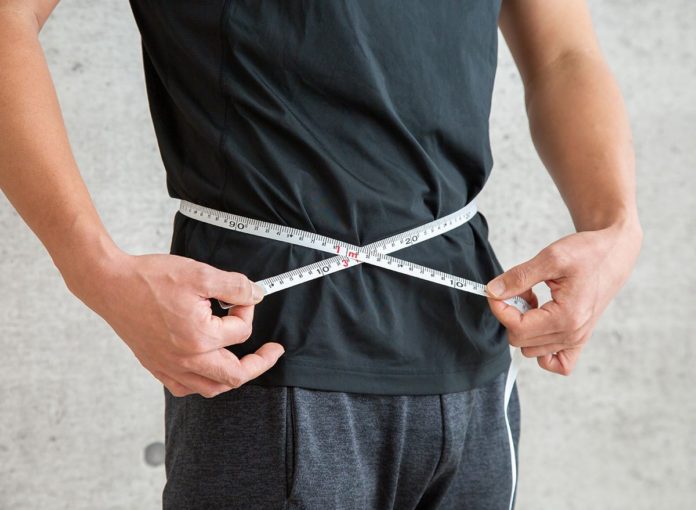Habit: It’s that thing that we do when we’re not paying attention to what we’re doing. And if you’re finally, comfortably starting to emerge after being quarantined during the last year, it’s extremely likely that you picked up at least one or two of those bad habits while you’ve been holed up at home.
But what if you could change your habits so that you could start losing fat automatically—without ever having to think about it? Research says that you can—and it’s easier than you think.
We found out which habits are causing you to gain the most belly fat, along with the cures for each. Try kicking these bad habits to the curb,
So, which habits are costing you the most? Check out which habits are truly the worst for when you’re targeting belly fat. And for more healthy tips, be sure to check out our list of 15 Underrated Weight Loss Tips That Actually Work.
According to Wake Forest researchers, dieters who sleep five hours or less put on 2 1/2 times more belly fat, while those who sleep more than eight hours pack on only slightly less than that. Shoot for an average of six to seven hours of sleep per night—the optimal amount for weight control.
Eat This, Not That! Fix: The National Sleep Foundation suggests seven to eight hours of sleep for most adults. And for the most productive night’s sleep possible, check out these 17 Surprising Ways to Lose Weight In Your Sleep.
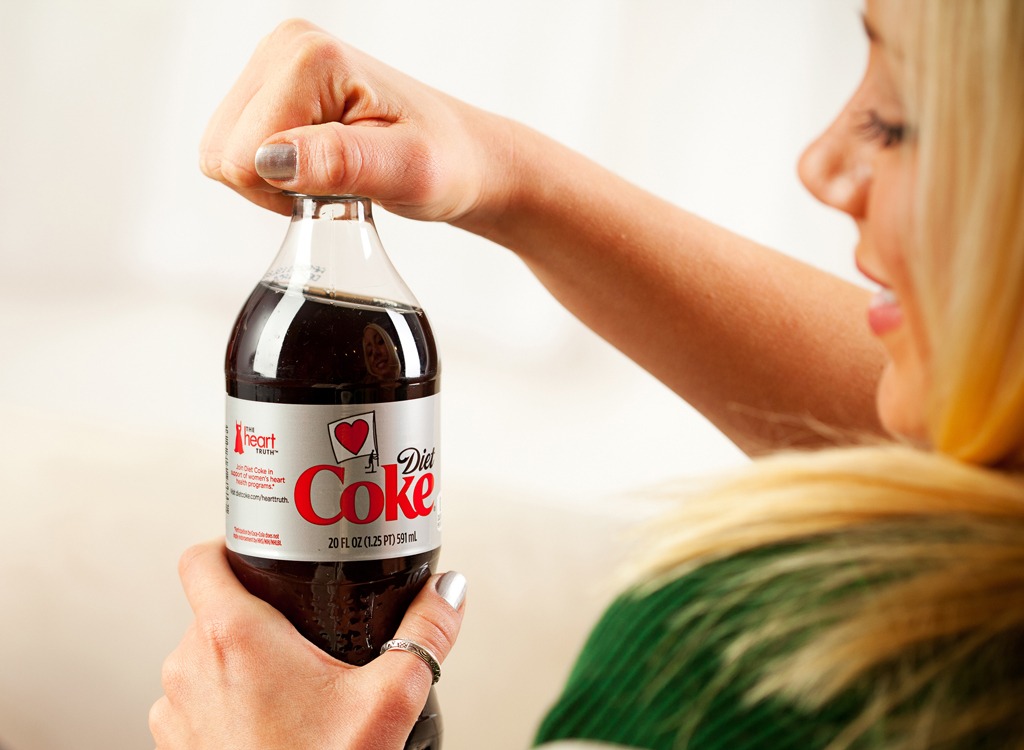
It’s a logical assumption: Switching from a sugar-based soda to a non-sugar-based soda should help your health. While calorically speaking that might be true, diet sodas contain their own dangers and side effects. In a shocking study, researchers at the University of Texas Health Science Center monitored 475 adults for 10 years and found that the participants who drank diet soda saw a 70 percent increase in waist circumference compared with those who didn’t drink any soda. So much for the idea that diet soda helps you get rid of belly fat!
That’s not all: The participants who drank more than two diet sodas a day suffered a 500 percent waist expansion. Yikes! The same researchers conducted a separate study on mice that indicates it might be the aspartame that causes the weight gain. Aspartame raises blood glucose levels to a point where the liver cannot handle it all, so the excess glucose is converted into fat.
Eat This, Not That! Fix: Drink black tea instead, for a caffeine buzz without the weight gain. And avoid these 28 Unhealthiest Sodas That Are Never Worth Drinking.
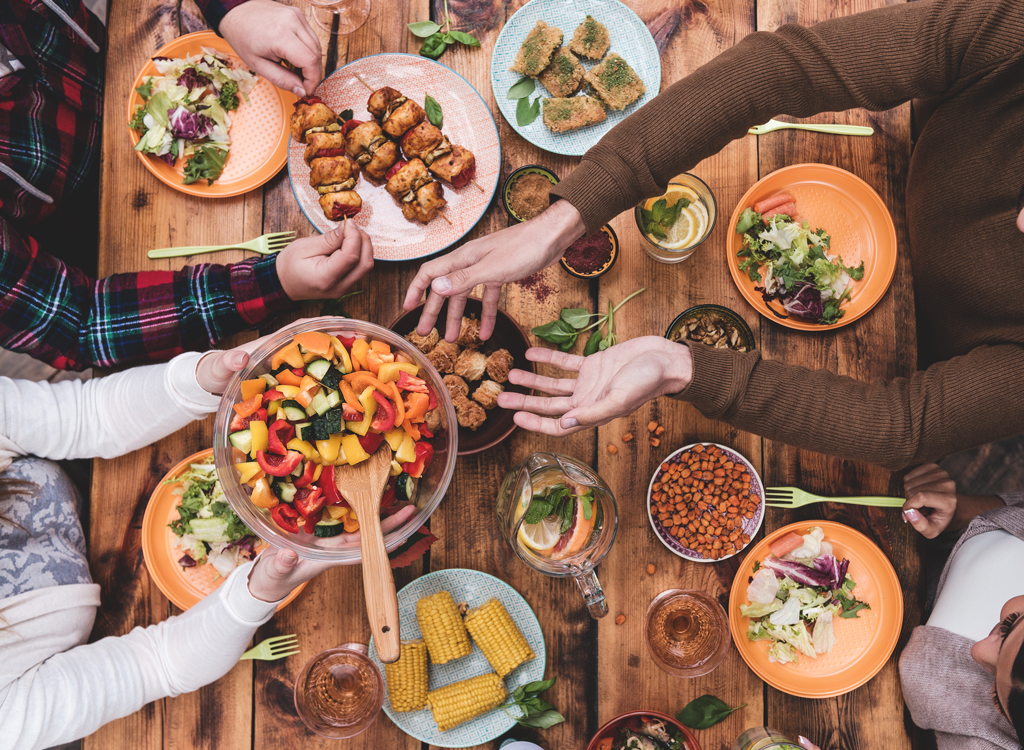
When we eat with other people, we consume, on average, 44 percent more food than we do when dining alone. Research published in the journal Nutrition found that a meal eaten with one other person was 33 percent larger than a meal savored alone. It gets scarier from there. Third-wheeling with two friends? You’re looking at a 47 percent bigger meal. Dining with four, six, or eight friends was associated with meal increases of 69, 70, and 96 percent, respectively. Though part of this has to do with the amount of time we spend at the table when dining with company, another study from the journal Appetite found people who spent longer eating because they were simultaneously reading didn’t eat significantly more, meaning time isn’t the only factor at play here.
Eat This, Not That! Fix: You can still hang out with your friends. Just vary the activity once in a while, and include short runs or walk-and-talks. You’ll save money and calories that are inflating your belly.
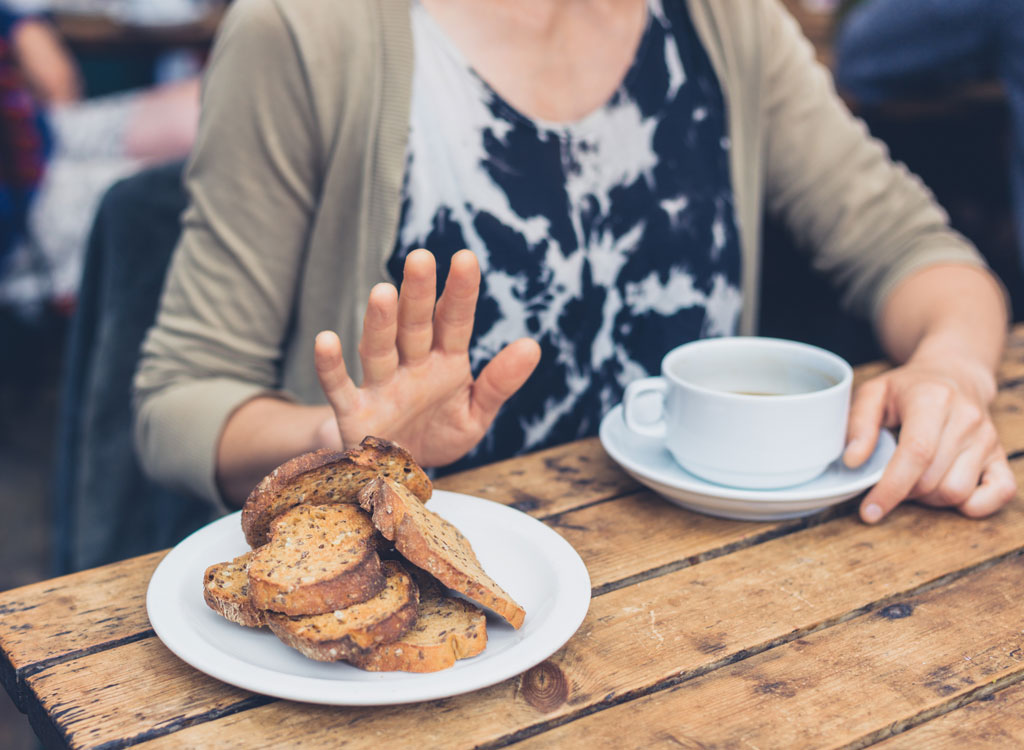
If you’ve just hopped on the Paleo or low-carb bandwagon, proceed with caution!
“Often diets that cut out entire food groups do not allow for the balance and moderation we need to follow a healthy, lifelong eating plan,” says Lori Zanini, RD, CDE. “Plus, dieters who follow these plans may be prone to potentially dangerous nutritional deficiencies. Or they may simply get bored with their restricted plan and end up overeating down the road,” warns Zanini.
Eat This, Not That! Fix: You don’t have to go too hard too fast. If you’ve finally reached a weight loss plateau and haven’t lost any more belly fat, consider taking a break from your diet. According to a recent study published in the International Journal of Obesity, dieters who took a two-week break from their low-calorie meal plan lost more weight than those who dieted consistently.

One Cornell study found that when given an option, a whopping 98.6 percent of obese individuals opt for larger plates. Translation: More food, more calories, and more belly fat.
Eat This, Not That! Fix: Keep your portions in check by choosing smaller serving dishes, and follow these 18 Easy Ways to Control Your Portion Sizes. If need be, you can always go back for seconds.

Keeping your cell phone around and your TV on is only going to keep you up later and cause you to mindlessly eat while you stare at your screen. A study by Lighting Research Center at Rensselaer Polytechnic Institute found that the light emitted from tech gadgets actually suppress melatonin production in the brain. This is the main sleep hormone for your body, so when you don’t have enough of it being produced you can suffer sleep complications. Plus, A study in Pediatric Obesity found students with access to one electronic device in their bedrooms were 1.47 times as likely to be overweight as those with no device in the bedroom. That increased to 2.57 times for kids with three devices.
Eat This, Not That! Fix: Turn your bedroom into a no-technology zone and opt to read a book while in bed if you’d like to wind down before hitting the hay.

Be mindful about eating mindfully. The practice has ancient Buddhist roots. It is, in fact, a form of secular meditation, asking us to experience food more intensely, paying close attention to the sensation and purpose of each bite. Mindful eating is not a diet—and it doesn’t ask you to eat less—but the approach is gaining traction as a successful weight-loss mechanism. In fact, recent studies have shown that mindful eaters respond less to emotional stress, consume significantly fewer calories, and, perhaps most importantly, have an easier time maintaining a healthy BMI compared with those who are unaware, according to a PLOS One study.
Eat This, Not That! Fix: To eat more mindfully to keep belly fat off your frame, chew slowly. Tune in to the texture, the smell, and the complexity of flavors. Keep chewing. Swallow. Take a sip of water. And for a few moments, resist the urge to take another bite. Continue this way throughout the course of a meal, and you’ll experience the pleasures and frustrations of mindful eating. Here are 8 Easy Ways to Eat Mindfully.

“We eat for many reasons, but the main prompt for mindful eating is physical hunger,” says registered dietitian nutritionist Leslie Schilling, MA, RDN. “It’s hard to be present if you’re eating at your desk, cyber-loafing, or watching television. When your mind is focusing on something besides your food, you don’t realize things like ‘Was the food actually good?’ and ‘Am I getting full?’ This often leads to ‘do-over eating,’ which isn’t so mindful. Eat with purpose and presence!” This distracted eating also leads to consuming more calories that turn straight to belly fat.
Eat This, Not That! Fix: A University of Vermont study found that overweight participants who reduced their TV time by just 50 percent burned an additional 119 calories a day on average. “Minimize distractions as often as possible,” says Schilling. In other words, that episode of Game of Thrones can be watched after dinner.

The warm smell of cinnamon, the charred stripes on a grilled chicken breast, the crunch of an apple…experts say paying attention to the sensory details of food is a simple way to start eating mindfully—and start dropping pounds. In fact, a study in the journal Flavour found that participants who took time to appreciate the aroma of a meal ate significantly less of a dish that smelled strongly than a mildly scented one. A second study found that people served a monochromatic plate of food—like fettuccine Alfredo on a white plate—ate 22 percent more than those served a more visually appealing meal that provided more color and contrast. Texture also comes into play. Researchers in Florida found that people tend to eat more of soft, smooth foods, which tend to be higher in fat, than hard, crisp ones. In one study, participants consumed more soft brownie bits than hard brownie bits until they were asked to focus on calorie content.
Eat This, Not That! Fix: Just being mindful of how things like aroma, mouthfeel, and food presentation can influence how much we eat can help increase the satisfaction we get from a meal and also prevent overeating.

If your body has one major flaw, this is it: It takes 20 minutes for your stomach to tell your brain that it’s had enough. A study in the Journal of the American Dietetic Association found that slow eaters took in 66 fewer calories per meal, but compared to their fast-eating peers, they felt like they had eaten more. What are 66 calories, you ask? If you can do that at every meal, you’ll lose more than 20 pounds a year!
Eat This, Not That! Fix: Put your fork down between every bite to slow your pace and keep yourself from overstuffing. It’s been proven: one PLOS One study found that people who focused on taking “small bites” of food consumed about 30 percent less soup for their meal than those who didn’t make the conscious decision. A second study in the Journal of the Academy of Nutrition and Dietetics found that simply slowing down had similar results. People who focused on doubling the number of times they chewed before swallowing ate 15 percent less food and 112 fewer calories over the course of a meal. So pump the brakes, and slow down to slim down.
Instead, try these tips on How to Control Your Hunger Hormones to Lose Weight Fast, According to Experts.

Adequate water intake is essential for all your body’s functions, and the more you drink, the better your chances of staving off belly fat. In one Virginia Tech study, dieting participants who were instructed to drink two cups of water before each meal lost 30 percent more weight than their thirsty peers. And you can magnify the effect by adding ice. German researchers found that six cups of cold water a day could prompt a metabolic boost that incinerates 50 daily calories. That’s enough to shed five pounds a year!
Eat This, Not That! Fix: You read the study results! Drink at least a glass of water before you sit down to each meal to decrease your calorie consumption. Here’s How Much Water You Need to Drink for Weight Loss.

A Journal of the American Dietetic Association study found that emotional eaters—those who admitted eating in response to emotional stress—were 13 times more likely to be overweight or obese. If you feel the urge to eat in response to stress, try chewing a piece of gum, chugging a glass of water, or taking a walk around the block. Create an automatic response that doesn’t involve food, and you’ll prevent yourself from overloading on calories.
Eat This, Not That! Fix: “Eat mindfully with intention and attention,” says Michelle May, MD, founder of Am I Hungry? Mindful Eating Programs. “Eat with the intention of feeling better when you’re finished eating than you did when you started, and eat with your full attention on the food and your body for optimal enjoyment and satisfaction.”
Here are 5 Ways to Quit Emotional Eating for Good.

Your office is on the fifth floor. You always take the elevator. Big mistake! Using the stairs burns twice as many calories. Still not convinced you should change your ways? A 150-pound person could lose about six pounds per year just by climbing up two flights of stairs every day, according to the University of New Mexico Health Sciences Center. Bump that up to six, and you could drop 18 pounds without ever hitting the gym.
Eat This, Not That! Fix: Not only should you be ditching the elevator upon your arrival, but find another excuse to take the stairs. Use the bathroom one floor below or the microwave that’s down two. It may be tough at first, but sooner or later you’ll see results and it’ll be well worth it.

Unfortunately, it is possible to have too much of a good thing. While skimping on sleep is associated with weight gain, researchers at Wake Forest found that those who sleep more than eight hours a night packed on more belly fat, the dangerous kind that’s associated with heart disease, diabetes, and stroke.
Eat This, Not That! Fix: Shoot for an average of six to seven hours of sleep per night—the optimal amount for weight control. And burn calories overnight with these 30 things to do 30 minutes before bed to lose weight.
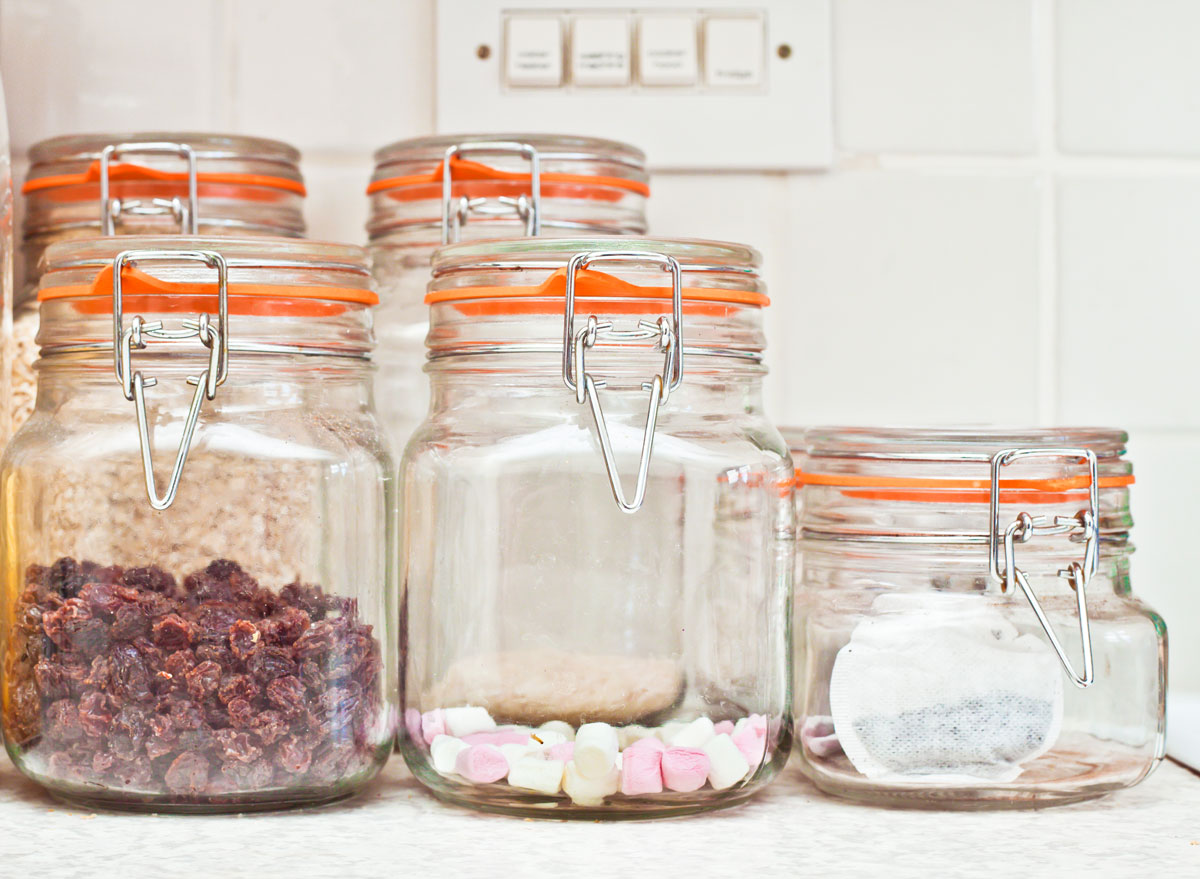
Our homes are filled with hidden eating traps, and simply being aware of something as simple as the size of a bowl can influence how much you eat. For example, a study conducted at Google’s New York office found that placing M&Ms in opaque containers as opposed to glass ones and giving healthier snacks more prominent shelf space curbed candy consumption by 3.1 million calories in just seven weeks. So what does that mean for your weight? The lesson here is clear: Clear junk food off your countertops to start losing weight and to make better choices.
Eat This, Not That! Fix: Bottom line: It’s easier to change your environment than to change your mind. Employ simple strategies like removing junk food from your line of sight to keep belly fat off your frame.
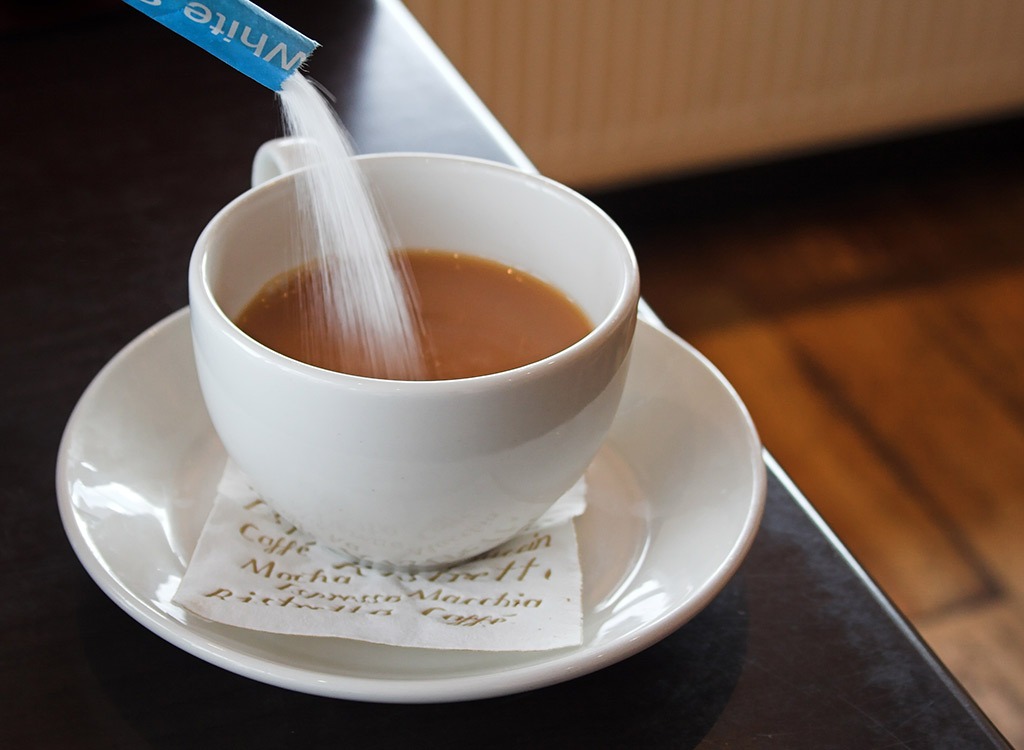
If your coffee tastes like ice cream, you’re doing it wrong. Adding packet upon packet of sugar will ultimately cause your blood sugar to spike and crash—which makes you crave unhealthy food—and can ultimately lead to weight gain. And it’s not just sugar you have to be worried about if you’re looking to save calories. According to a 2017 study published in the journal Public Health, researchers found that nearly 70 percent of coffee consumers drink coffee with caloric add-ins (including sugar and creamers); out of those people, close to 16 percent of their daily caloric intake came from sipping on their coffee concoction. That 16 percent translates to an additional 70 calories a day more than non-coffee drinkers.
Eat This, Not That! Fix: Try using other flavor boosters to make up for the sweet stuff, such as cinnamon or cocoa powder, both of which are often available at your local coffee shop. And if you crave that sweetness, go for the less processed stuff. Stevia, which is now available at Starbucks (just ask if it isn’t out) was proven to help minimize spikes in blood glucose and insulin, according to a study in the journal Appetite.

Eating late in the evening is a great way to go up a couple of pant sizes. Research published in Obesity Society shows that eating dinner earlier in the day can help with weight loss because you have more time to burn off the calories. Remember that the next time you’re hankering for a slice of pizza late night.
Eat This, Not That! Fix: Stick to a consistent dinner time and schedule it for early in the evening. If you happen to have a late dinner, consider going for a walk afterwards to get your metabolism going.
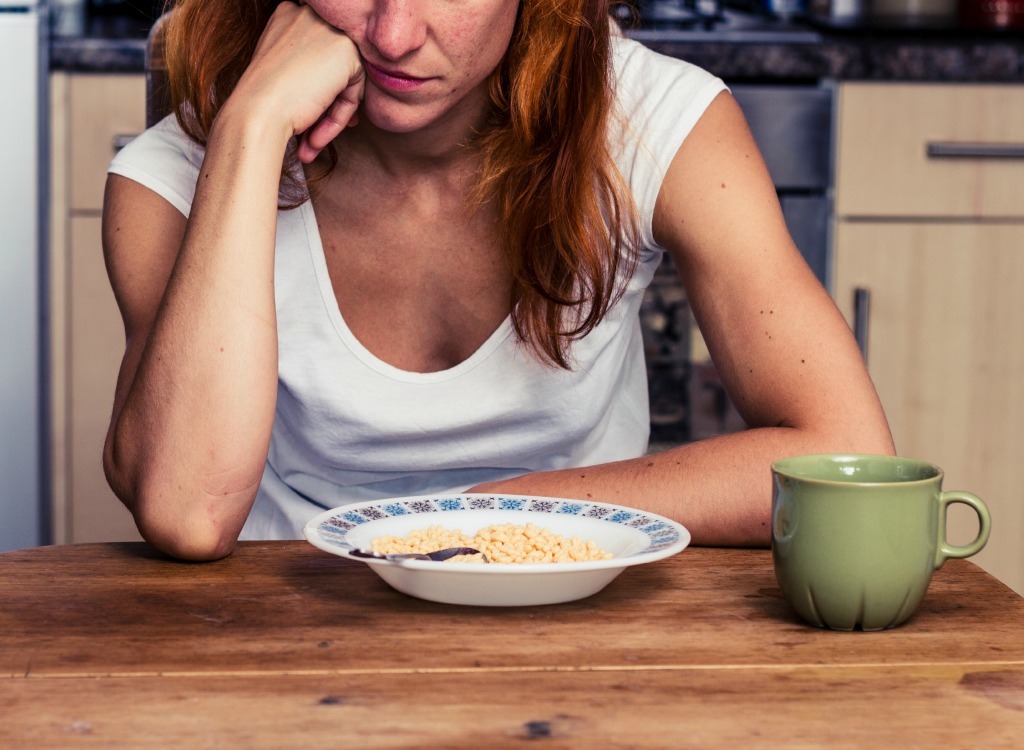
According to a study published by Frontiers in Psychology, people have the tendency to eat when they’re bored.
Eat This, Not That! Fix: Before you pick up that afternoon snack, ask yourself if you’re really hungry or just eating because you don’t have anything else to do. Try reading a book, meditating, or writing in a journal to keep your mind (and your stomach) preoccupied.

Adjusting the temperature in your room is a simple fix to a smaller pants size. According to research published in Cell Press, regular exposure to mild cold can actually boost weight loss. The researchers noted that a Japanese study found that participants who stayed in colder temperatures (around 62 degrees) for six weeks saw a significant decrease in body fat.
Eat This, Not That! Fix: Make sure to turn your thermostat down and take off any extra blankets when the weather starts to get warm. Because your body temperature naturally falls when you begin to fall asleep, the colder room will help you sleep soundly and keep belly fat off your frame.
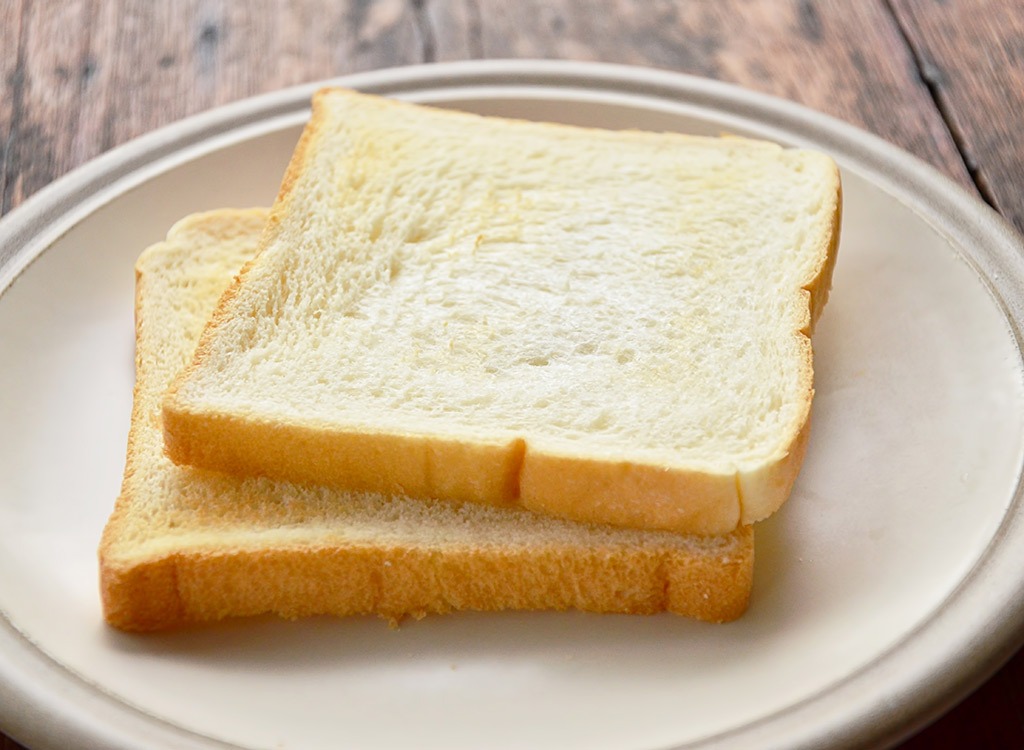
Ask any diet expert what they think about fiber, and they’ll likely explain that it’s an imperative part of any weight-loss goal. So, if you tend to skimp on the nutrient by purchasing white bread products, it could explain why you’ve been packing on the pounds. Refined wheat flours, such as white bread, pizza, pasta, and bagels, have been stripped of their slow-digesting fiber, which means your body can break down what you just consumed very quickly.
And the faster your body digests these foods, the faster your blood sugar levels rise, which leads to spikes in your insulin levels and ends with fat accumulation.
According to multiple studies published in The American Journal of Clinical Nutrition, those who consume the most refined grains have the most amount of belly fat and largest mean BMI and waist circumference, whereas those who eat the most high-fiber, whole grain foods have the lowest amounts of belly fat.
Eat This, Not That! Fix: We know change is hard, but making the switch to whole grain is well worth it. Find fiber in all of your foods. Adding berries such as raspberries and blueberries to your morning oats is a smart move. These fruits carry over 6 grams of the belly-filling stuff per cup. Not to mention, they’re low in sugar and filled with flavor. “According to research from Wake Forest Baptist Medical Center, eating foods rich in soluble fiber, like oatmeal (one of the best carbs for weight loss), apples, and beans, can reduce belly fat,” says registered dietitian nutritionist Jennifer McDaniel.
Here’s why fiber is The #1 Thing To Eat Every Day To Lose Weight For Good.

…or a drink! But just because your BFF got a promotion, or you finally moved into your new home, doesn’t mean you need to overload on champagne and cookies. In fact, you should do the opposite. Leah Kaufman, MS, RD, CDN explains that rewarding yourself with food is a very slippery slope.
“Oftentimes, I see my patients reward a weight loss by indulging in foods they know aren’t the best for their goals,” says Kaufman. “Instead, I suggest using things like manicures, SoulCycle classes, and workout gear as a reward for all their hard work. Using junk food will only contribute to weight gain and lead to unhealthy yo-yo dieting.”
Eat This, Not That! Fix: There are plenty of ways to celebrate these achievements without junk. If you went on a congratulatory trip to the beach three times a year instead of devouring a fancy dinner out, you could keep nearly 4,000 calories out of your mouth. That sums up to a little more than a pound of fat!
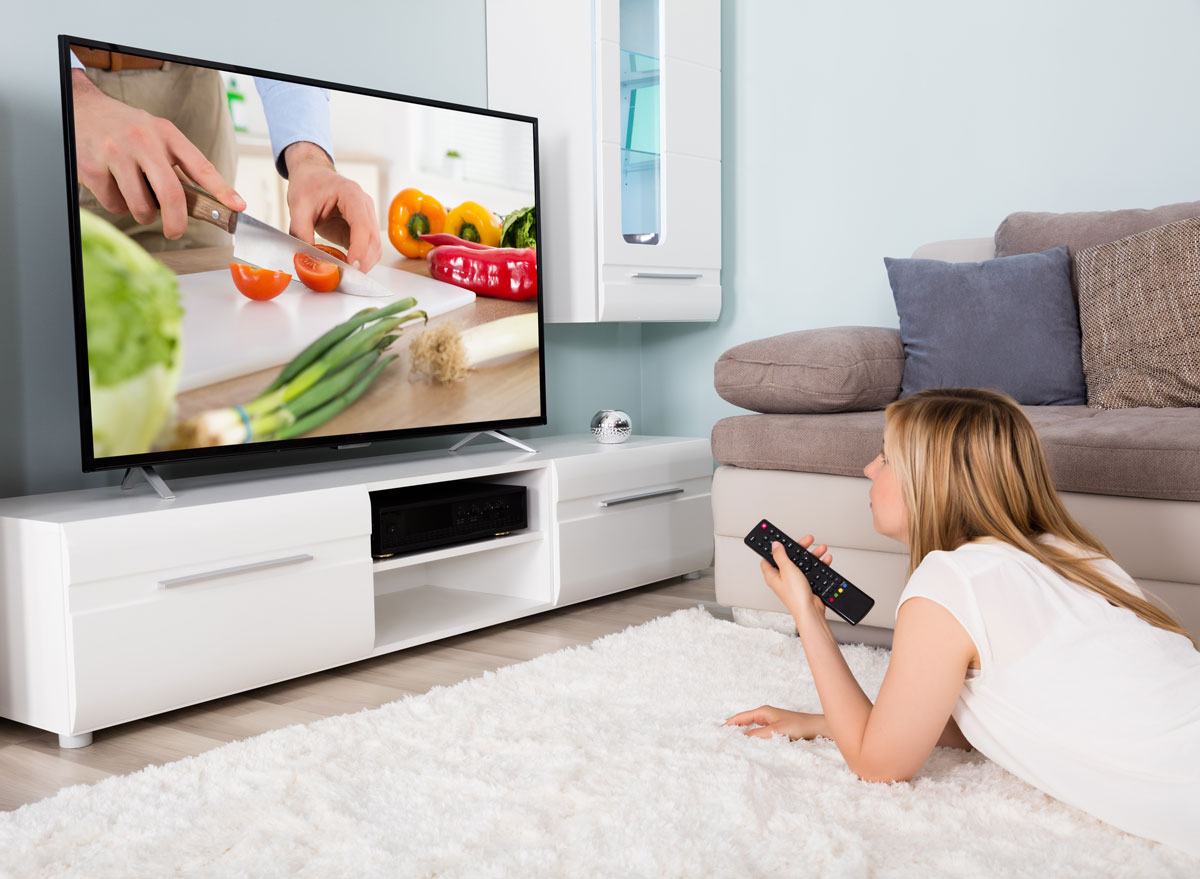
Chopped, Top Chef, Chef’s Table—these appetite-enhancing shows are doing more than making us hungry, they’re making us fat!
“Television recipes often contain more calories, protein, and fat than the experts recommend,” says Mary Hartley, RD, MPH a consulting nutritionist from Rhode Island. “According to a study from Cornell, watching cooking shows and then cooking from scratch is associated with a higher body mass index (BMI). However, cooking show viewers who watch but don’t cook do not have higher BMIs.” So feel free to watch, but sorry Ina, we can’t cook up the food.
Eat This, Not That! Fix: Watch the shows, let them inspire you, but make them flat-belly friendly. Change one fattening ingredient to one of these 40 Best-Ever Fat-Burning Foods and enjoy.

Time spent on Netflix as opposed to at the gym is obviously not a flat-belly move. But it’s more than just a lack of gym time that’s packing on the pounds; a study conducted at the University of Vermont found that overweight participants who cut back half of their normal TV time saved an additional 119 calories a day on average. Watching just one less show (if you only watch two) would be an automatic 12-pound annual loss!
Eat This, Not That! Fix: Make the most of your TV time by multitasking while you watch—fold some laundry, or plank and wall sit during commercial breaks. An easy load of chores can further bump up your caloric burn. And if your hands are busy washing the dishes or making your kids lunch, then they won’t be in the popcorn bag! Mindlessly snacking is a tummy trap during this sacred time. Check out these 31 No-Gym Workouts to get inspired.

If your lunch break is consistently you running out to a local spot or out the door to meet a delivery guy, then chances are you’re eating up more calories, salt, and sugar than if you just ate lunch from home. Restaurant options are often spiked with diet-destroying sauces and belly-bloating sodium. And when you eat out, you often say “yes” to more than you need. And your local place is just as to blame as the McDonald’s down the block. A study published in the Journal of the American Academy of Nutrition and Dietetics found that restaurant food is as caloric as fast-food. Researchers found that 92 percent of meals gathered from both large-chain and local restaurants in three cities contained on average 1,205 calories—nearly 60 percent of the FDA’s daily recommended intake of 2,000.
Eat This, Not That! Fix: To stay away from those unwanted calories, brown bag it. With these 25 Super-Healthy Lunches Under 400 Calories, you’re set to make an awesome week’s worth of lunches.
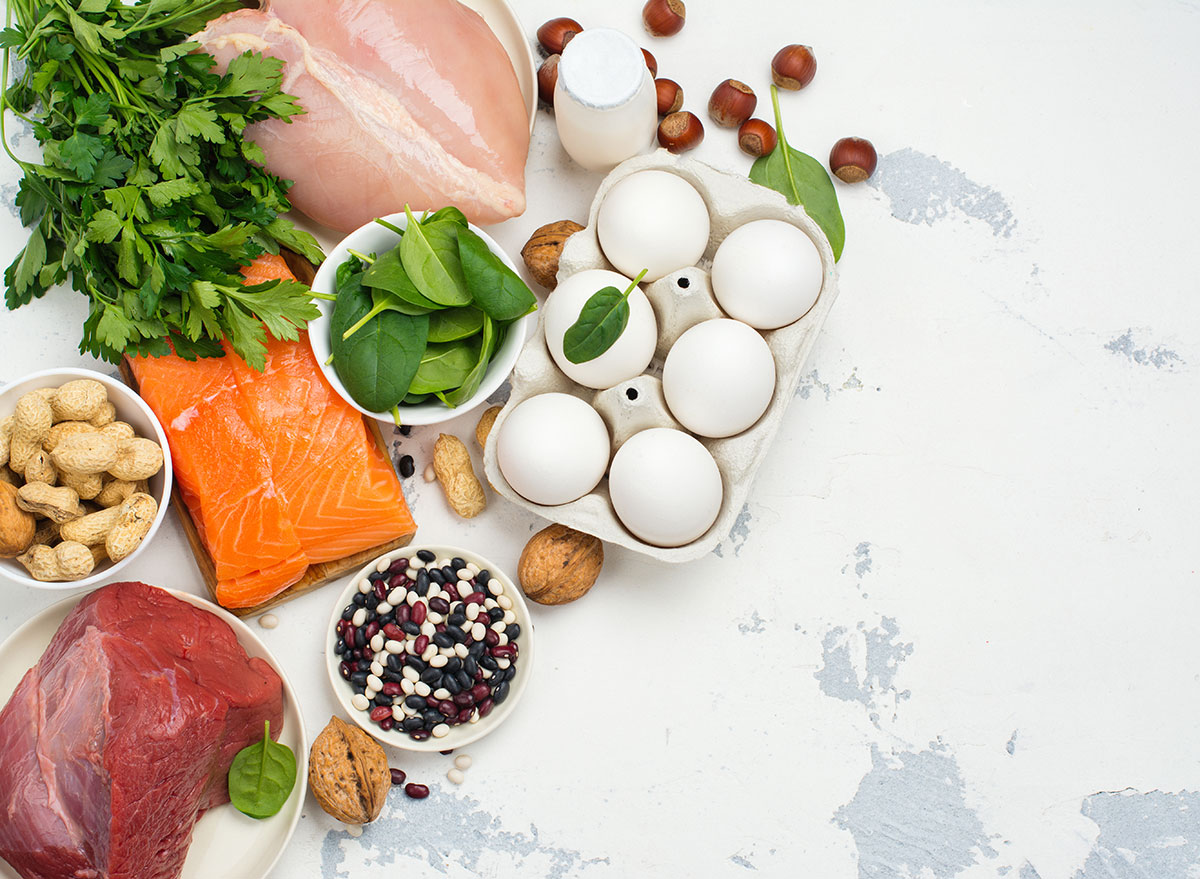
A high-protein, low-carb diet may help your extra pounds fly off initially, but it can actually cause weight gain in the long term, according to a recent Spanish study. Researchers had more than 7,000 participants fill out questionnaires about their eating habits over the course of six years. After analyzing the data for commonalities, they found that those who ate high-protein diets had a 90 percent greater risk of gaining more than 10 percent of their body weight during the course of the study than those who ate less of the stuff. Yikes!
Eat This, Not That! Fix: Instead of going heavy on the meat, “make half your plate vegetables and/or salad,” says nutritionist and dietitian Danielle Omar, blogger at Food Confidence. The vegetables are nutrient-dense, high in satiating fiber, and low in calories. By eating the veggie half of your plate before anything else, you will take the edge off your hunger, eat less overall calories, and still feel full and satisfied.

If you’re a sucker for a packaged, salty kick, chances are that’s part of the reason for your widening belly. And it’s not all water weight, either. A study published in the Journal of Nutrition discovered that salt actually confuses the biological processes that tell you when you’re full.
“Our body has biological mechanisms to tell us when to stop eating, and fat activates those mechanisms in people who are sensitive to the taste of fat,” lead author Russell Keast says. “However, when salt is added to the food, those mechanisms are blunted and people end up eating more food. This can cause you to eat more fatty foods, and over time, your body adapts or becomes less sensitive to fat, leading you to eat more to get the same feelings of fullness.”
Eat This, Not That! Fix: Cooking at home? Use fresh herbs instead of salt. When dining out, scan the nutrition info at home before you head out and pick a low-calorie dish with about 1,000 milligrams of sodium or less. And make sure to avoid the worst orders at popular restaurants.
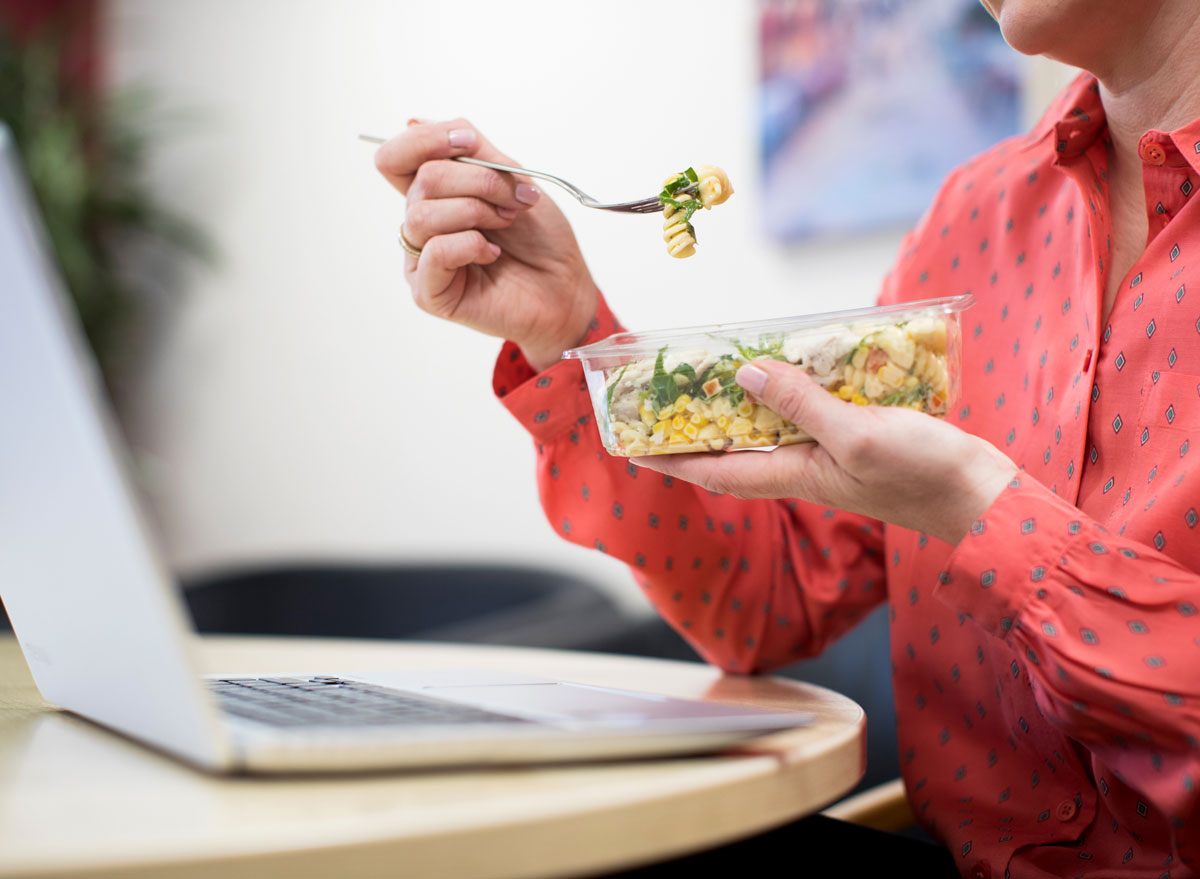
You may think it’s beneficial for your hourly pay, or to prove yourself to your boss, but eating your lunch at your desk isn’t doing your waistline any favors. And you’re not the only one doing this. According to research conducted by NPD group, roughly 62 percent of working American professionals dine “al-desko.” The issue is that you’re eating distractedly, which can cause you to consume up to 50 percent more calories than you intended, according to a 2013 review in the American Journal of Clinical Nutrition.
Eat This, Not That! Fix: Invite a colleague, take a walk to the salad shop, and eat it there! Taking a break will help you refresh your mind and give you control over your caloric intake.
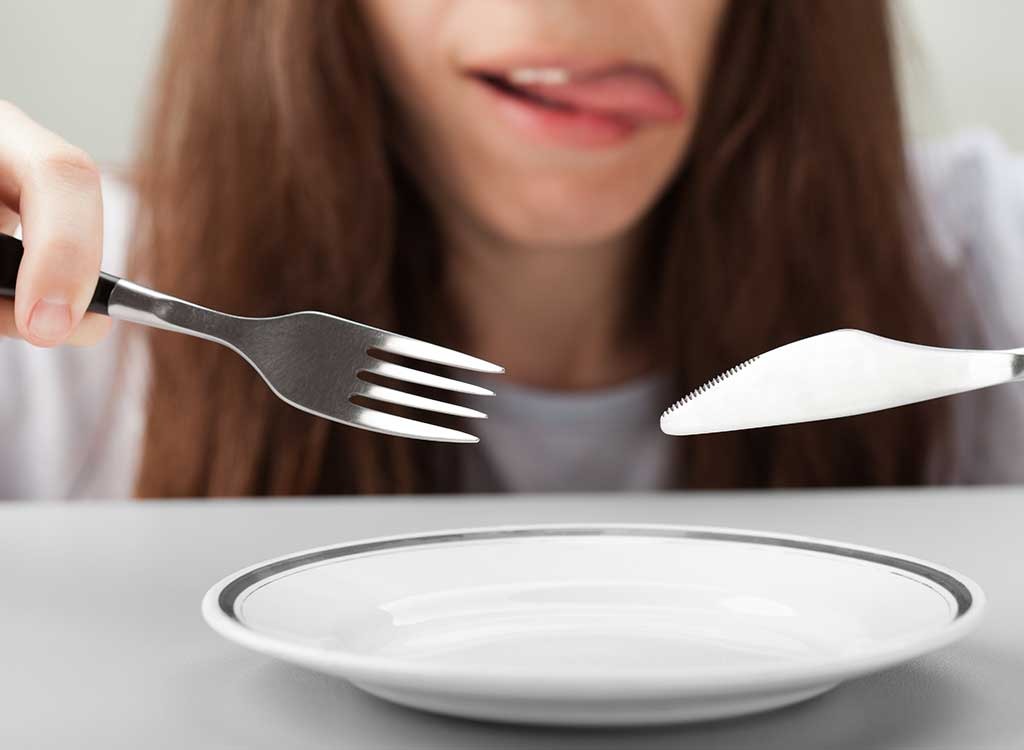
Your stomach makes some noise. You’re hungry, right? Maybe not. A study in the journal Physiology & Behavior found that 60 percent of the time people confused hunger for thirst. Drinking water is a simple trick to stay on track with those weight-loss goals. This may simply be because water is filling, but researchers note the added H2O may well be displacing calories otherwise spent on calorie-laden beverages. “If all else fails, have a cup of tea, which has almost no calories,” recommends Kelly Choi, author of The 7-Day Flat-Belly Tea Cleanse. “Tea can help hydrate you and calm down cravings!”
Eat This, Not That! Fix: Even if you’re sure those rumbles are for hunger, preloading meals with some good ol’ calorie-free H2O can shave some calories. And if plain water sounds boring, you can add some practically calorie-free fresh citrus to create a health-boosting (and flavorful!) detox water.
Here’s What Happens to Your Body When You Stop Drinking Water.

In a 2011 national survey from the Calorie Control Council, 17 percent of Americans admitted to skipping meals to lose weight. The problem is, skipping meals actually increases your odds of obesity, especially when it comes to breakfast. A study from the American Journal of Epidemiology found that people who cut out the morning meal were 4.5 times more likely to be obese. Why? Skipping meals slows your metabolism and boosts your hunger. That puts your body in prime belly fat-storage mode and increases your odds of overeating at the next meal.
Eat This, Not That! Fix: Don’t say you don’t have time for breakfast; it’s easy if you make these overnight oats!

If you think you’re doing yourself a favor by ordering a lighter fare, you may be surprised to learn you’re not. That’s because when you are under the impression you chose the better option, you tend to let up on restraint. In fact, consumers tend to choose beverages, side dishes, and desserts that contain up to 131 percent more calories when they ordered a “healthy” main dish, according to a study from the Journal of Consumer Research.
A separate Babson College study even found that the mere presence of healthy meals on a menu can actually cause people to select a less nutritious meal. Experts believe that people end up splurging because they take the fact that they count the consideration of ordering a healthy item as being virtuous, so it leads them to make poor food choices down the line. Plus, not all lighter fare dishes are as healthy as they sound.
Eat This, Not That! Fix: To keep your slim-down plans in line, take a peek at the restaurant’s menu options in advance. Many chains have nutritional facts readily available, and knowing what you take in will rid you of any guilty feelings later as long as you stick to your plan. If you’re considering ordering lunch, placing an order ahead of when you’ll start to feel hungry can also help you cut down on calories, according to research published in the Journal of Marketing Research.
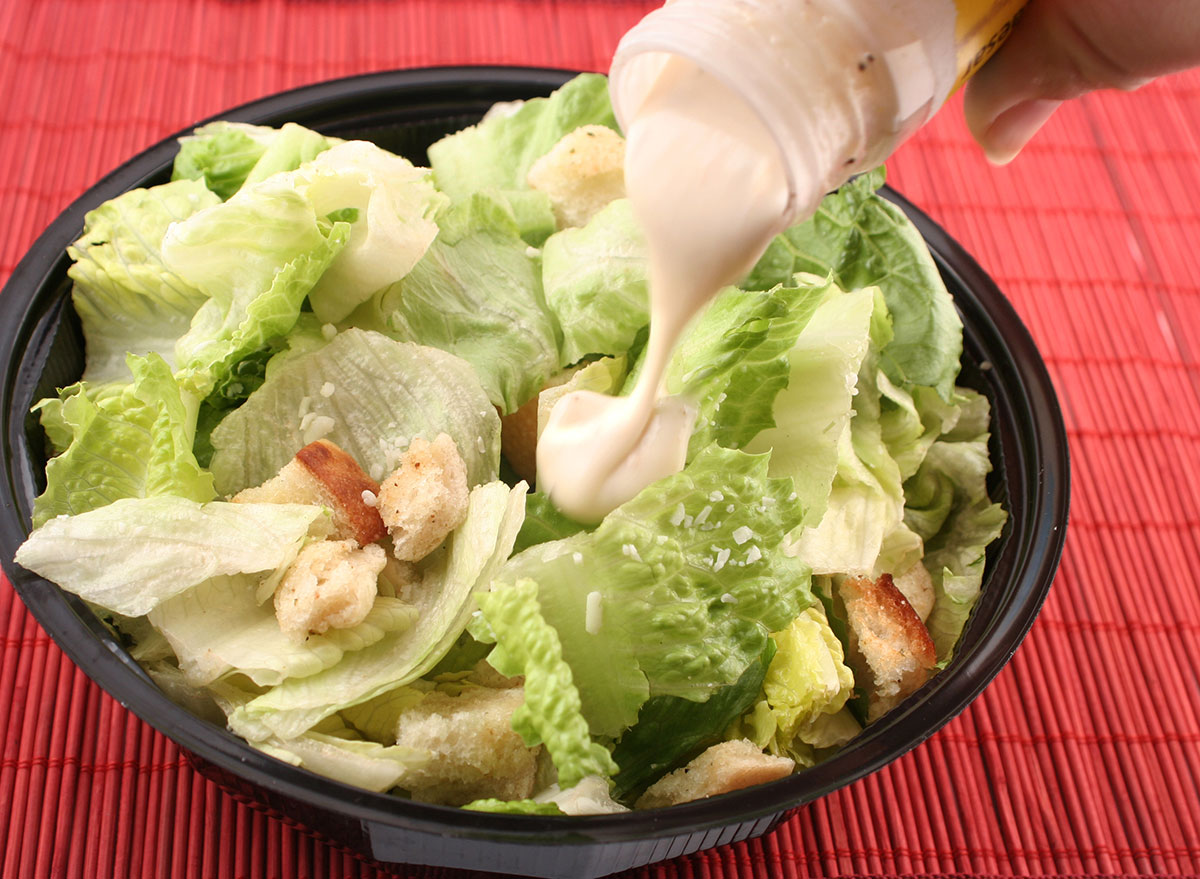
Restaurant chefs tend to soak their meals in deep, treacherous puddles of oil, cream, butter, and sugar—all of which are calorically dense and offer little to no nutritional benefits. By asking for your veggies and meat to be cooked dry and leaving sauces on the side, you could save loads of calories. Simple renditions like this on your order can lead to major weight loss success.
Eat This, Not That! Fix: If you’re not already making this request when you dine out and order in, it’s time to start. Ask for your chicken and broccoli dish steamed, leaving the sauce on the side. When you order, ask for a side of fruit with your veggie-filled omelet rather than going for the oil-drenched potatoes. Or one of these 15 Healthy Meals to Order at Chain Restaurants, According to Dietitians.
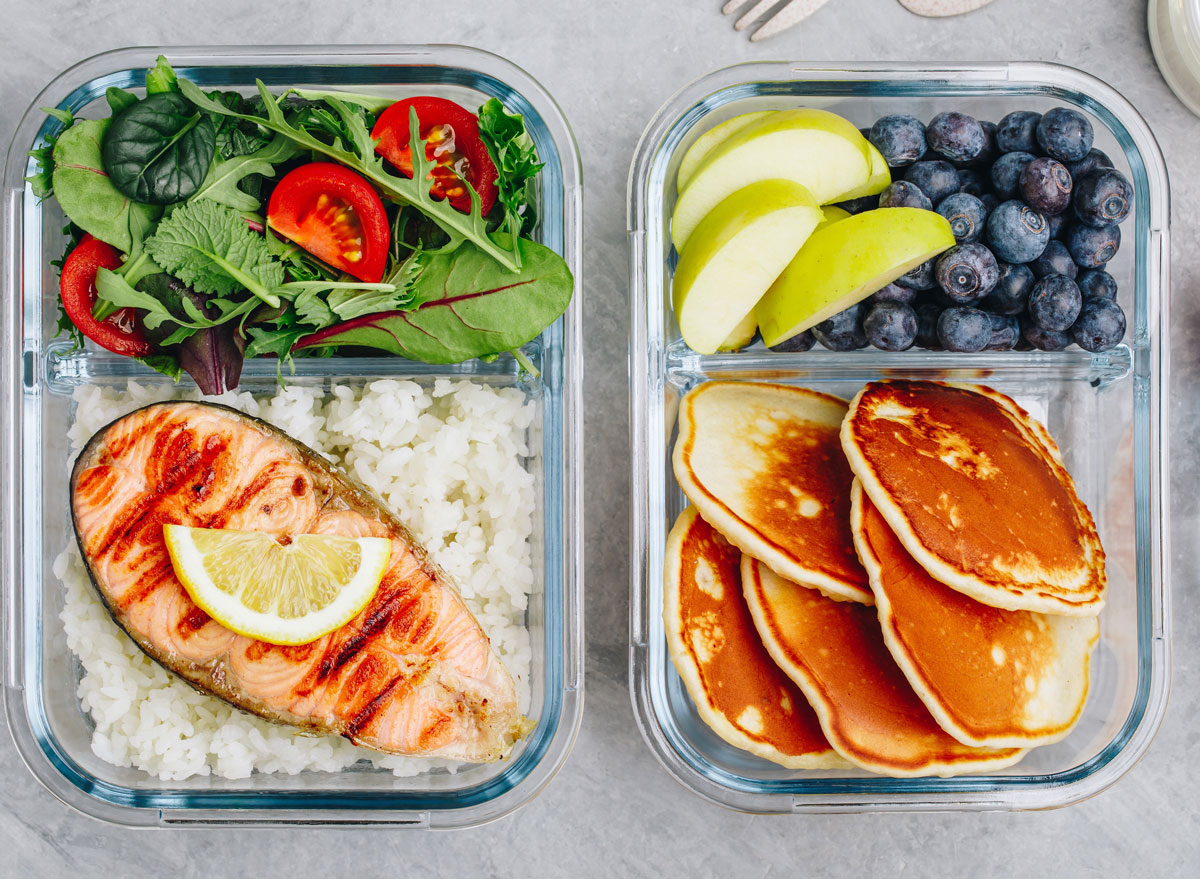
Despite diet experts and new research constantly telling you otherwise, many people still consume the bulk of their calories in two or three large meals each day, often—in an attempt to slim down—going for hours at a time eating nothing in between. Sure, you can lose weight on a reduced-calorie three-meal plan, but you can’t make your body burn fat more efficiently, which is key to long-term weight loss.
Eat This, Not That! Fix: A nutritious meal or snack about every three hours keeps blood-sugar levels stable, feeds your body a steady stream of necessary nutrients, and helps control hunger-induced cravings for less-than-slimming snacks like sweets and fats. It also leads to more effective glycogen storage in the liver and muscle tissues, ensuring that your body won’t cannibalize muscle as an energy source during your workouts. So make your meals mini, and spread them out. If you have trouble fitting in extra eating times at work, prepare food ahead of time that you can zap in the microwave or eat cold.
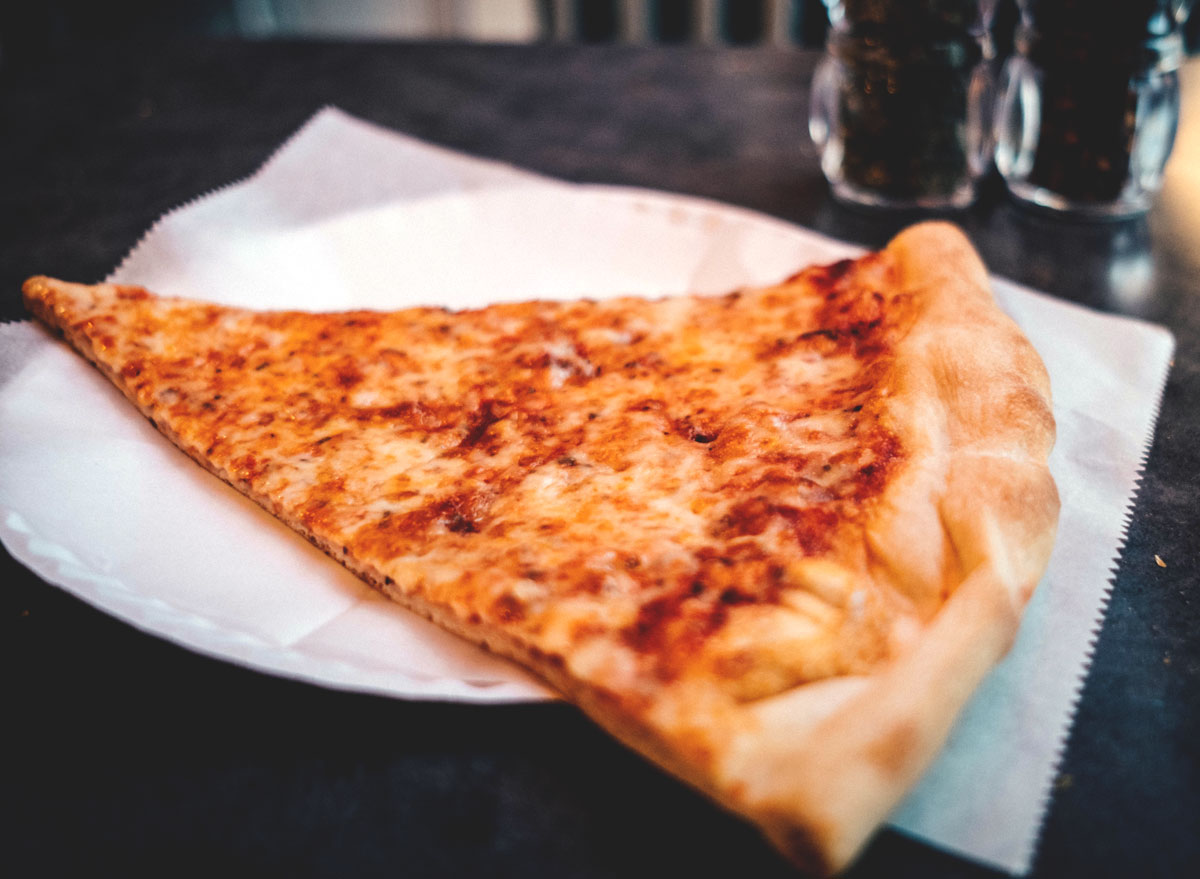
Allowing your cycle of good days and bad days to dictate your eating habits can set your diet up for failure. We’re not saying that a cheat meal isn’t allowed. In fact, quite the opposite:
“Occasionally indulging can aid weight-loss efforts by warding off feelings of deprivation and bouts of overeating,” says dietitian Cassie Bjork, RD, LD of Healthy Simple Life. “It can make it easier to stick with your healthy eating regimen for the long haul.” Rather, it’s when you let your emotions dictate your eating routine or when one diet slip-up causes a cascade of poor eating decisions where you can run into a problem.
Eat This, Not That! Fix: We have two suggestions for you: Either keep your hard work in line by picking your cheat meal in advance and be sure to jump right back on the healthy eating bandwagon afterward, no matter how good a second greasy meal may sound. Or, choose a meal plan that’s realistic. If you’re a dairy lover, days without cheese, yogurt, and ice cream will be quite painful. Instead, allow yourself one meal a day with a little bit of the good stuff. That way, you never feel deprived.
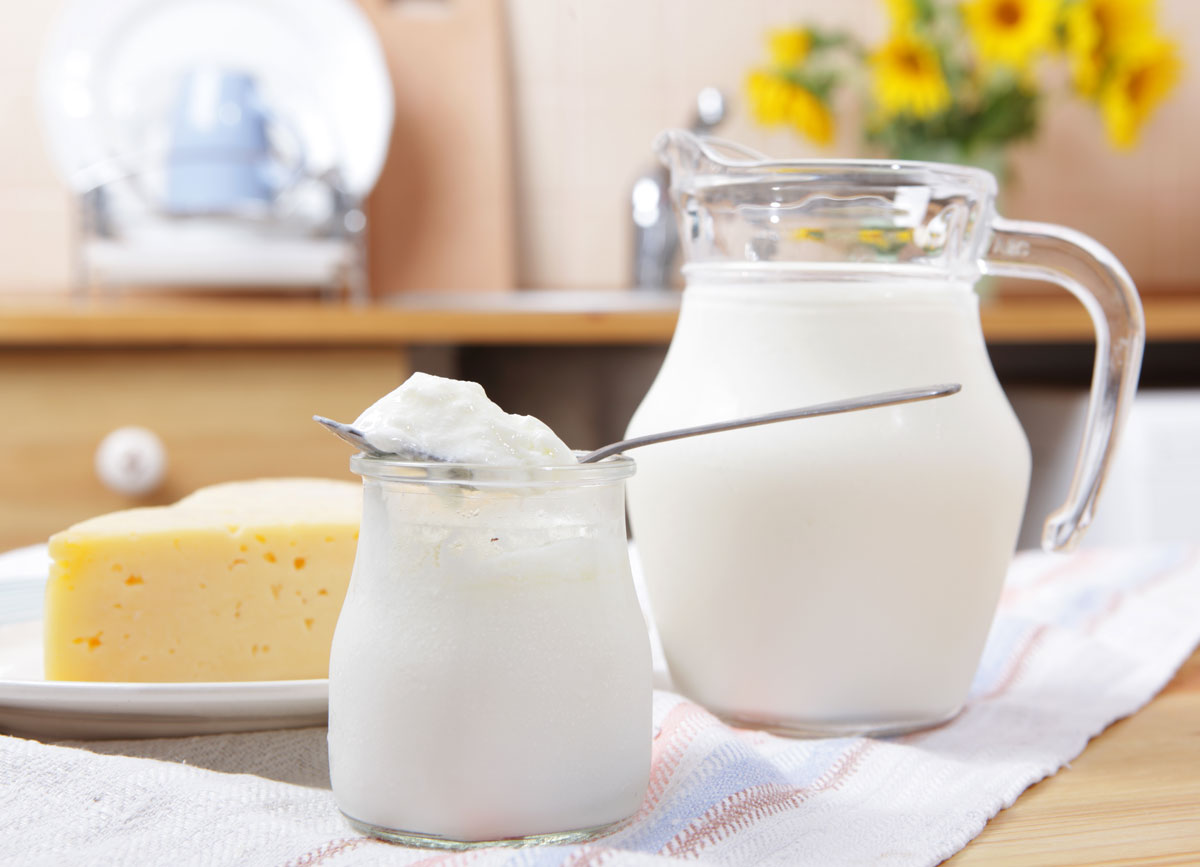
It’s time to get fat—not around your waist, but on your plate. Stop buying foods marketed as low-fat or fat-free. Typically, they save you only a few calories, and, in doing so, they replace harmless fats with low-performing carbohydrates that digest quickly—causing a sugar rush and, immediately afterward, rebound hunger. Researchers from the University of Alabama at Birmingham found that meals that limited carbohydrates to 43 percent were more filling and had a milder effect on blood sugar than meals with 55 percent carbohydrates. That means you’ll store less belly fat and be less likely to eat more later.
Eat This, Not That! Fix: Check out these 20 Best Full-Fat Foods for Weight Loss.

Good news here: By reading this, you’re already forming habits that can help you shed belly fat. When New Zealand researchers sent diet and exercise advice to 491 people, they found that the recipients began eating smarter and working more physical activity into their daily routines. Not surprisingly, the habits of the non-recipients didn’t budge.
Eat This, Not That! Fix: Take note of the incredible advice we received in our list of The Best Nutrition Tips.

The UCLA Center for Human Nutrition researchers divided study participants into two groups, each of which was fed a nearly identical low-cal diet for 12 weeks. The only difference between the groups was what they were given to eat as an afternoon snack. One group ate 220 calories of pretzels while the other group munched on 240 calories’ worth of pistachios. Just four weeks into the study, the pistachio group had reduced their BMI by a point, while the pretzel-eating group stayed the same, and their cholesterol and triglyceride levels showed improvements as well.
Eat This, Not That! Fix: Enjoy pistachios—and almonds—but click here for the 100 Unhealthiest Foods on the Planet so you know what to avoid.

Ideally, we sleep about eight hours for every 24. Most people spend an extra seven to 10 hours sitting at their desk. That means most of us spend the overwhelming majority of our time sedentary. Our bodies weren’t designed for this level of inactivity. Most of human evolutionary history has involved being active, searching for food and fuel. Nutritionist Lisa Jubilee, MS, CDN says that one way to burn more calories daily is to stand more and sit less. She cites a British study that found that standing at work burned 50 more calories an hour than sitting. If that doesn’t sound like a lot, consider this: If you stand for just three hours every day, in one year you’ll expend more than 30,000 extra calories—which amounts to about 8 pounds of fat.
Eat This, Not That! Fix: Set a phone timer to remind you to get up every hour and walk around, even for a few minutes. Just two minutes every hour can offset the predicted pounds, according to a Clinical Journal of the American Society of Nephrology study.
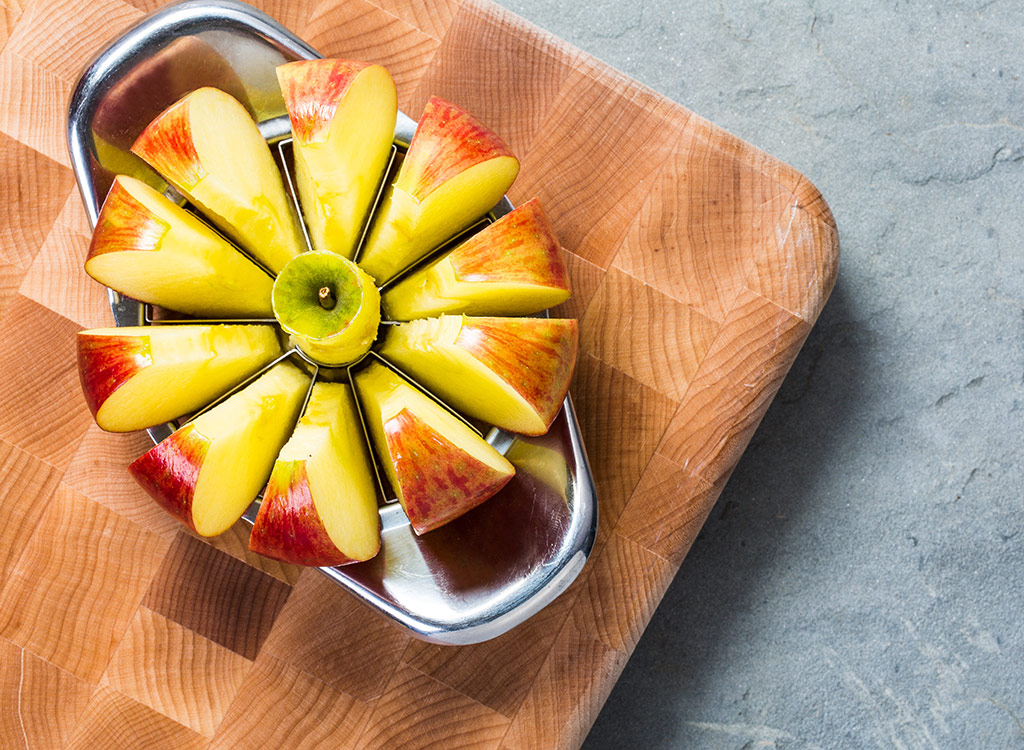
While it may sound counterintuitive, eating before going to a work dinner or happy hour can actually take off pounds. A series of studies out of Penn State found that noshing on an apple or a broth-based soup prior to sitting down to a restaurant meal can reduce total calorie intake by 20 percent. With the average restaurant meal weighing in at 1,128 calories, saving 20 percent once a day could help you lose up to 23 pounds this year.
Eat This, Not That! Fix: You don’t have to reach for an apple or soup to keep your appetite in check. Any of these “50 Best Snacks for Weight Loss” should do the trick.
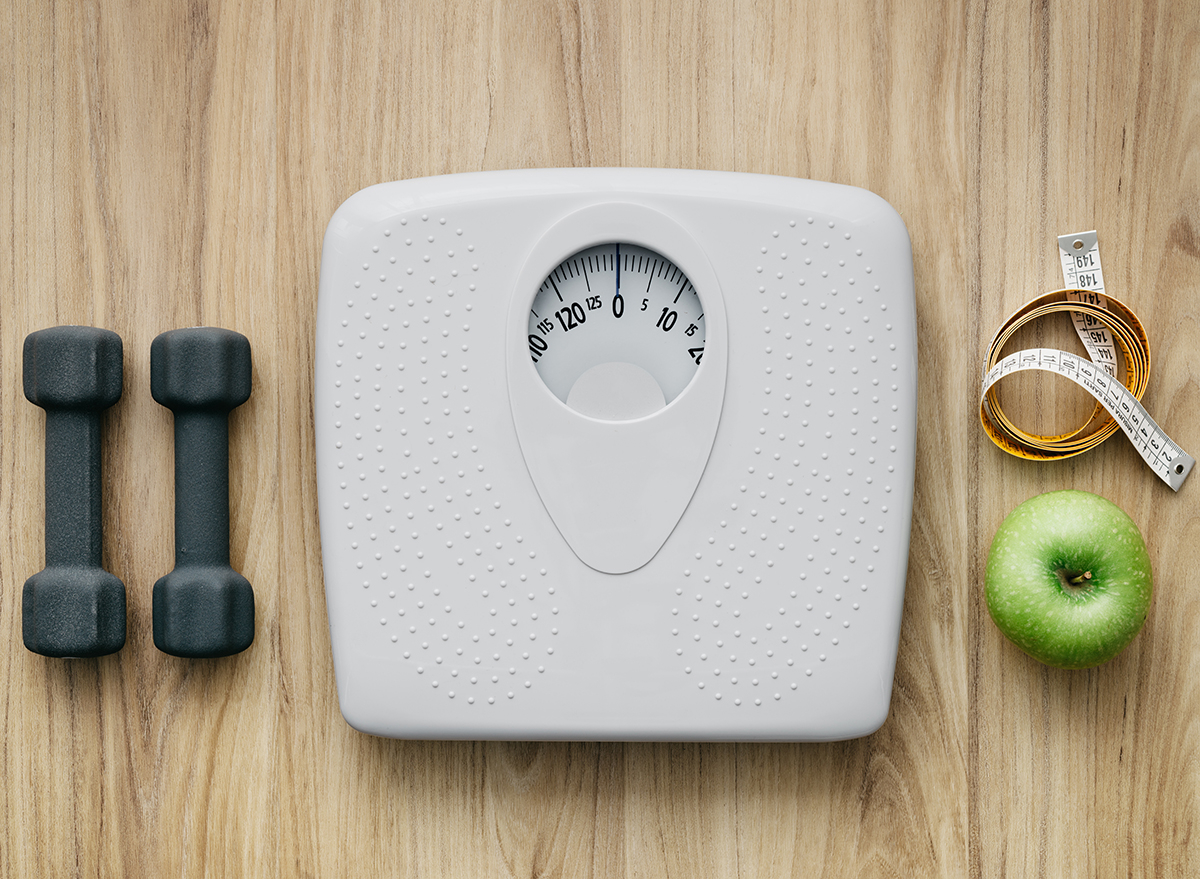
Abandon your habit of stepping on the scale completely, and research has shown your weight is likely to creep up. University of Pittsburgh School of Nursing researchers found that people who never weighed themselves or only stepped on a scale once a week did not lose weight in the following year. However, dieters who weighed themselves every day a week lost an average of 1.7 percent of their body weight in 12 months.
Eat This, Not That! Fix: To get the most accurate measurement, weigh yourself once a week in the morning before breakfast.
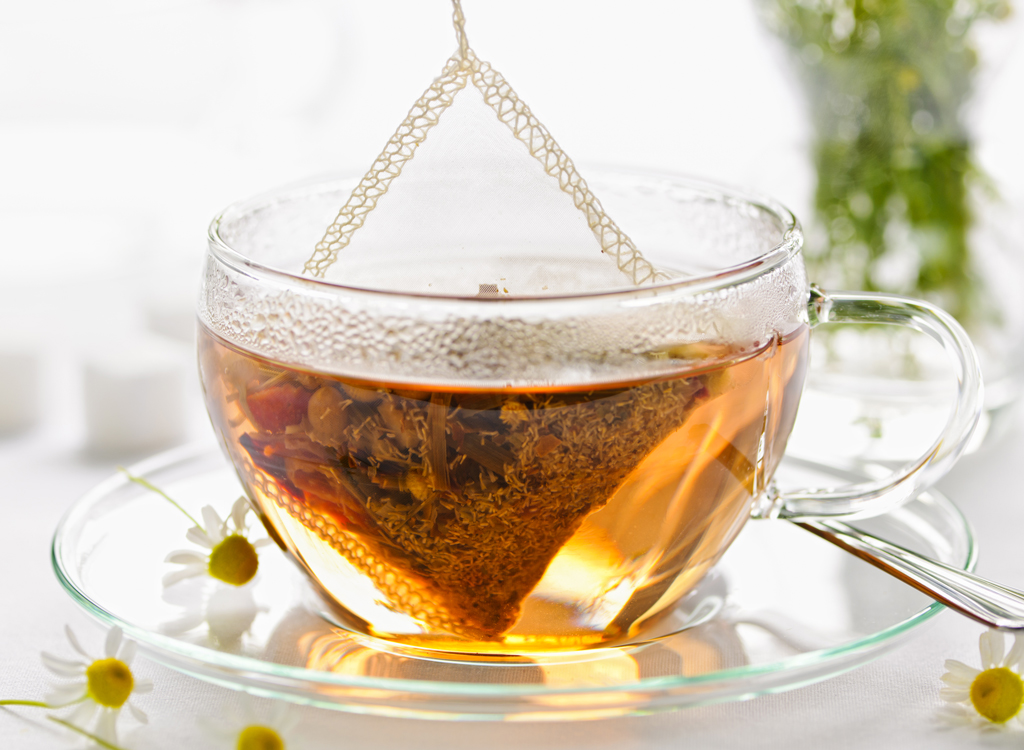
A steaming cup of tea is the perfect drink for soothing a sore throat, relaxing at night, or binge-watching your favorite TV show. But certain teas are also perfect for doing something else—helping you lose extra weight. Pu-erh tea, for example, can literally shrink the size of your fat cells! To discover the brew’s fat-crusading powers, Chinese researchers divided rats into five groups and fed them varying diets over a two-month period. In addition to a control group, there was a group given a high-fat diet with no tea supplementation and three groups that were fed a high-fat diet with varying doses of pu-erh tea extract. The researchers found that the tea significantly lowered triglyceride concentrations (potentially dangerous fat found in the blood) and belly fat in the high-fat diet groups. It’s a natural fat blaster, along with barberry, rooibos, and white tea.
Eat This, Not That! Fix: We love pu-erh so much, we made it part of our weight-loss plan, The 7-Day Flat-Belly Tea Cleanse.

